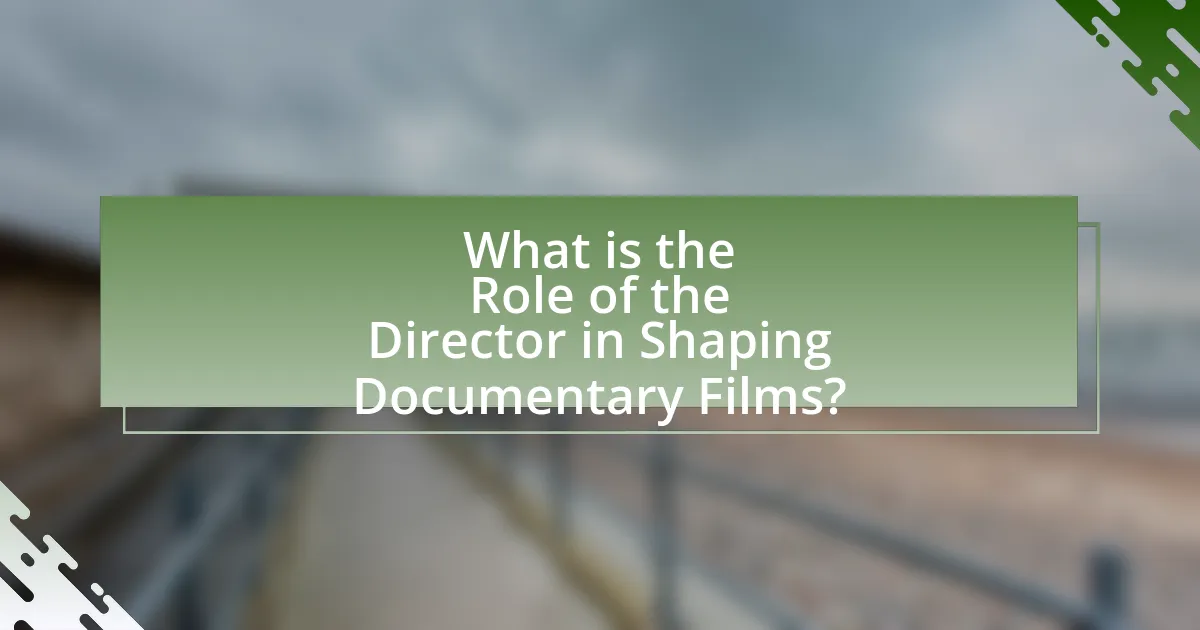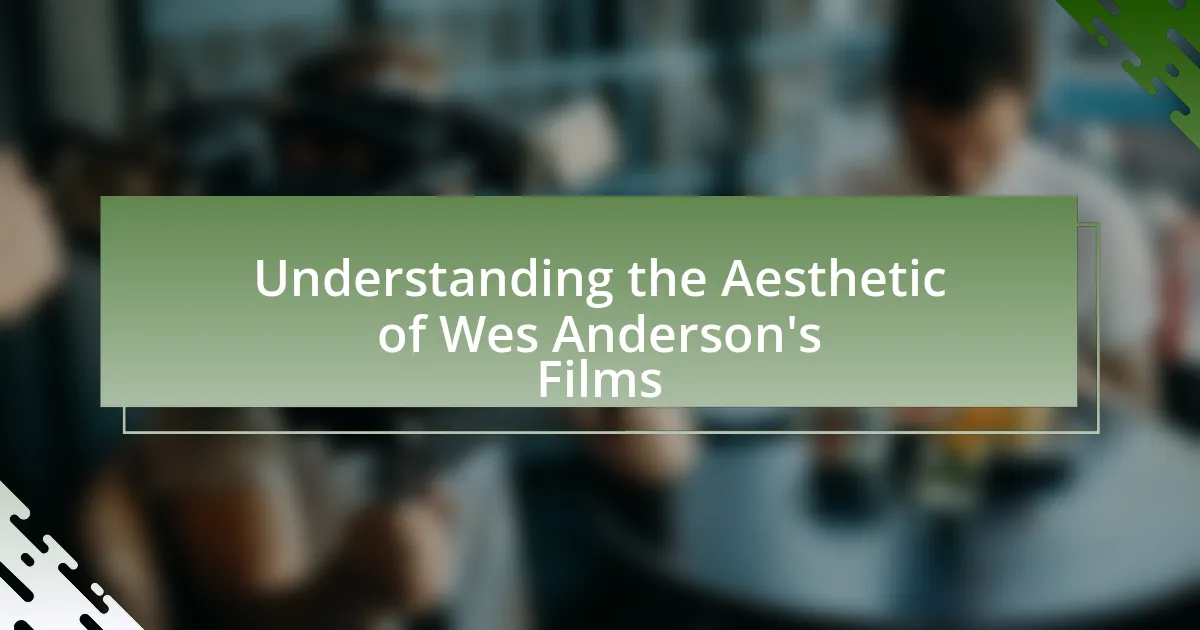The article examines the pivotal role of the director in shaping documentary films, with a particular focus on the techniques and contributions of Errol Morris. It outlines how directors guide narrative structure, influence visual style, and convey emotional depth through innovative methods such as the Interrotron. Key responsibilities of directors, including ethical storytelling and balancing factual accuracy with narrative engagement, are discussed alongside the challenges they face in the documentary filmmaking process. The article also highlights Morris’s impact on the genre, emphasizing themes of truth, memory, and morality, and offers practical insights for aspiring documentary filmmakers.

What is the Role of the Director in Shaping Documentary Films?
The role of the director in shaping documentary films is to guide the narrative, influence the visual style, and determine the overall message of the film. Directors like Errol Morris utilize their vision to select subjects, frame interviews, and edit footage, which significantly impacts how the audience perceives the story. For instance, Morris’s use of the Interrotron, a device that allows subjects to look directly into the camera while speaking, creates a unique intimacy that shapes viewer engagement and emotional response. This technique exemplifies how a director’s choices can transform raw footage into a compelling narrative that resonates with audiences.
How does a director influence the storytelling in documentary films?
A director influences the storytelling in documentary films by shaping the narrative structure, selecting the subjects, and determining the visual style. For instance, Errol Morris, known for his innovative techniques, utilizes interviews and reenactments to create a compelling narrative that engages viewers emotionally and intellectually. His film “The Fog of War” exemplifies this, as he combines archival footage with personal interviews to explore complex themes of war and morality, effectively guiding the audience’s understanding of the subject matter. This approach demonstrates how a director’s choices can significantly impact the storytelling and overall message of a documentary film.
What techniques do directors use to convey their vision?
Directors use various techniques to convey their vision, including storytelling, visual composition, and sound design. Storytelling techniques involve structuring narratives to engage audiences emotionally and intellectually, often utilizing interviews and personal anecdotes to create a connection with the subject matter. Visual composition includes the use of framing, lighting, and camera angles to enhance the emotional tone and thematic elements of the film. Sound design, which encompasses music, ambient sounds, and voiceovers, further enriches the narrative by influencing the audience’s perception and emotional response. These techniques are essential in shaping the overall impact of a documentary, as demonstrated in Errol Morris’s works, where he effectively combines these elements to create compelling narratives that resonate with viewers.
How does a director’s style impact the audience’s perception?
A director’s style significantly impacts the audience’s perception by shaping the narrative, visual aesthetics, and emotional engagement of a film. For instance, Errol Morris employs a distinctive interview technique and a unique visual style that emphasizes the subject’s perspective, which can evoke empathy and provoke critical thought among viewers. His use of the Interrotron, a device that allows subjects to look directly into the camera while speaking, creates a sense of intimacy and authenticity, enhancing the audience’s connection to the narrative. This approach has been shown to influence how audiences interpret the truthfulness of the documentary content, as evidenced by Morris’s films like “The Thin Blue Line,” which not only challenged perceptions of justice but also reshaped public discourse around the cases he depicted.
Why is the director’s vision crucial in documentary filmmaking?
The director’s vision is crucial in documentary filmmaking because it shapes the narrative, influences the storytelling approach, and determines the emotional impact of the film. A clear vision allows the director to select relevant themes, guide the cinematography, and curate interviews that align with the intended message. For instance, Errol Morris, known for his unique style, utilizes his vision to explore complex subjects, as seen in “The Fog of War,” where his perspective on Robert S. McNamara’s life and decisions drives the film’s narrative structure and emotional resonance. This focused direction ensures that the documentary not only informs but also engages the audience, making the director’s vision a fundamental element in the filmmaking process.
What are the key responsibilities of a director in this genre?
The key responsibilities of a director in the documentary genre include shaping the narrative, guiding the production team, and ensuring the authenticity of the content. A director must craft a compelling story by selecting relevant subjects, conducting thorough research, and making editorial decisions that reflect the truth of the subject matter. Additionally, the director oversees the filming process, coordinating with cinematographers and editors to create a cohesive visual style that enhances the storytelling. For instance, Errol Morris, known for his innovative techniques, emphasizes the importance of interviews and the use of reenactments to convey complex narratives, demonstrating how a director’s vision can significantly influence the final product.
How does a director balance factual accuracy with narrative engagement?
A director balances factual accuracy with narrative engagement by carefully selecting and presenting information that enhances storytelling while remaining truthful to the subject matter. For instance, Errol Morris employs techniques such as interviews and reenactments to create compelling narratives that draw viewers in, while ensuring that the core facts are preserved and accurately represented. This approach allows for emotional resonance and audience connection without sacrificing the integrity of the documentary’s content. Morris’s film “The Fog of War” exemplifies this balance, as it combines Robert S. McNamara’s personal reflections with historical context, providing both an engaging narrative and factual depth.
What challenges do directors face in documentary filmmaking?
Directors face several challenges in documentary filmmaking, including securing funding, managing ethical considerations, and navigating the unpredictability of real-life events. Funding is often limited, making it difficult for directors to realize their vision; for instance, a study by the International Documentary Association found that 60% of documentary filmmakers reported financial constraints as a significant barrier. Ethical considerations arise when portraying real individuals and events, requiring directors to balance storytelling with respect for their subjects’ dignity and privacy. Additionally, the unpredictable nature of documentary subjects can lead to unforeseen complications during production, as real-life events may not unfold as planned, impacting the narrative structure and overall message of the film.
How do directors navigate ethical dilemmas in their work?
Directors navigate ethical dilemmas in their work by adhering to established ethical guidelines, engaging in reflective practices, and prioritizing transparency. For instance, documentary filmmakers like Errol Morris often grapple with the responsibility of representing truth while also considering the impact of their narratives on subjects and audiences. Morris, known for his innovative techniques, emphasizes the importance of ethical storytelling, which includes obtaining informed consent and being mindful of the portrayal of vulnerable subjects. This approach is supported by the International Documentary Association’s ethical guidelines, which advocate for honesty and integrity in documentary filmmaking. By following these principles, directors can effectively address ethical challenges while maintaining the credibility of their work.
What role does funding play in a director’s creative choices?
Funding significantly influences a director’s creative choices by determining the scope, resources, and overall feasibility of a project. For instance, a higher budget allows for advanced technology, skilled personnel, and extensive research, which can enhance storytelling and production quality. Conversely, limited funding may restrict a director’s ability to execute their vision fully, leading to compromises in aspects such as location, talent, and post-production. Historical examples, such as Errol Morris’s “The Fog of War,” demonstrate how financial backing enabled the use of innovative techniques and access to prominent figures, ultimately shaping the film’s narrative and impact.

How has Errol Morris shaped the documentary film landscape?
Errol Morris has significantly shaped the documentary film landscape through his innovative storytelling techniques and the use of the Interrotron, a device that allows subjects to speak directly to the camera while maintaining eye contact with the interviewer. This approach has transformed the way documentaries engage audiences, creating a more intimate and personal connection between the viewer and the subject. Morris’s films, such as “The Thin Blue Line” and “Fog of War,” have not only garnered critical acclaim but have also influenced the genre by blending elements of narrative cinema with factual storytelling, thereby expanding the boundaries of documentary filmmaking. His work has demonstrated the power of documentary to explore complex themes and provoke thought, establishing a new standard for the genre that emphasizes emotional depth and psychological insight.
What are the defining characteristics of Errol Morris’ directorial style?
Errol Morris’ directorial style is characterized by a unique blend of innovative interview techniques, a focus on the subjective nature of truth, and the use of stylized visual elements. Morris often employs the “Interrotron,” a device that allows subjects to speak directly to the camera while maintaining eye contact, creating an intimate connection that reveals personal truths. His documentaries frequently explore complex moral and philosophical questions, emphasizing the ambiguity of truth through the perspectives of his interviewees. Additionally, Morris incorporates reenactments and archival footage, enhancing the narrative and providing a multifaceted view of the subject matter. These characteristics are evident in acclaimed works such as “The Thin Blue Line,” which not only challenged the legal system but also showcased his distinctive approach to storytelling.
How does Morris utilize interviews to enhance storytelling?
Errol Morris utilizes interviews to enhance storytelling by employing a unique approach that emphasizes the emotional and psychological depth of his subjects. He often conducts in-depth, open-ended interviews that allow subjects to express their thoughts and feelings freely, which creates a more intimate and engaging narrative. For instance, in his film “The Fog of War,” Morris uses a series of interviews with former U.S. Secretary of Defense Robert S. McNamara, allowing McNamara’s reflections on war and morality to drive the film’s narrative structure. This method not only provides personal insights but also encourages viewers to connect with the subject on a human level, thereby enriching the overall storytelling experience.
What innovative techniques has Morris introduced in his films?
Errol Morris has introduced several innovative techniques in his films, notably the use of the “Interrotron,” a device that allows subjects to speak directly to the camera while maintaining eye contact with the interviewer. This technique enhances the emotional connection between the viewer and the subject, creating a more intimate and engaging experience. Additionally, Morris employs a unique narrative style that blends archival footage with contemporary interviews, allowing for a multifaceted exploration of truth and memory. His films often challenge traditional documentary conventions by incorporating elements of dramatization and subjective storytelling, which encourages viewers to question the nature of reality and representation in film.
Why is Errol Morris considered a pivotal figure in documentary filmmaking?
Errol Morris is considered a pivotal figure in documentary filmmaking due to his innovative approach to storytelling and the use of technology in his films. His work, particularly in films like “The Thin Blue Line,” revolutionized the genre by blending investigative journalism with cinematic techniques, leading to a new understanding of truth in documentary. Morris’s introduction of the “Interrotron,” a device that allows subjects to speak directly to the camera while maintaining eye contact with the interviewer, has transformed the way personal narratives are presented in documentaries. This technique enhances emotional engagement and authenticity, making his films resonate deeply with audiences. His contributions have not only influenced contemporary documentary filmmakers but have also sparked discussions about the ethics and responsibilities of documentary storytelling.
What impact has Morris had on the perception of truth in documentaries?
Errol Morris has significantly influenced the perception of truth in documentaries by challenging traditional notions of objectivity and presenting truth as a subjective construct. His innovative techniques, such as the use of the Interrotron, allow subjects to speak directly to the camera, creating a more intimate and personal narrative that blurs the lines between fact and interpretation. Morris’s films, like “The Thin Blue Line,” have demonstrated how storytelling and perspective can shape the audience’s understanding of reality, leading to a broader acceptance of the idea that documentaries can convey emotional truths rather than just factual accuracy. This shift has prompted both filmmakers and viewers to reconsider the role of the director in shaping narratives and the complexities of truth in documentary filmmaking.
How have Morris’ films influenced other documentary filmmakers?
Errol Morris’ films have significantly influenced other documentary filmmakers by pioneering innovative storytelling techniques and challenging traditional narrative structures. His use of the “Interrotron,” a device that allows subjects to speak directly to the camera while maintaining eye contact, has inspired filmmakers to create more intimate and engaging interviews. Additionally, Morris’ focus on complex moral questions and the subjective nature of truth has encouraged other documentarians to explore deeper philosophical themes in their work. For instance, films like “The Fog of War” and “Standard Operating Procedure” have set a precedent for blending personal narrative with broader historical contexts, prompting filmmakers to adopt similar approaches in their documentaries.
What themes are prevalent in Errol Morris’ work?
Errol Morris’ work prominently features themes of truth, memory, and the nature of reality. His documentaries often explore the complexities of human perception and the subjective nature of truth, as seen in films like “The Fog of War,” which examines Robert S. McNamara’s reflections on war and morality. Morris employs innovative techniques, such as the Interrotron, to capture intimate interviews that reveal personal narratives, emphasizing how individual memories shape one’s understanding of events. Additionally, his exploration of the fallibility of memory is evident in “Standard Operating Procedure,” which critiques the portrayal of events at Abu Ghraib, highlighting how visual evidence can be manipulated. These themes collectively underscore Morris’ inquiry into the reliability of human experience and the multifaceted nature of documentary storytelling.
How does Morris explore the concept of memory in his films?
Errol Morris explores the concept of memory in his films by utilizing innovative storytelling techniques and interviews that reveal the subjective nature of recollection. He often presents conflicting narratives from different individuals, highlighting how personal experiences shape memory and influence perception. For instance, in “The Fog of War,” Morris examines Robert S. McNamara’s reflections on the Vietnam War, showcasing how memory can be selective and influenced by time. This approach underscores the complexity of memory as a construct rather than a mere record of events, emphasizing that it is often colored by emotions and biases.
What role does morality play in Morris’ storytelling approach?
Morality plays a central role in Errol Morris’ storytelling approach by shaping the ethical framework within which his documentaries operate. Morris often explores complex moral dilemmas, prompting viewers to confront uncomfortable truths and question their own ethical beliefs. For instance, in “The Fog of War,” he examines the moral implications of war through the lens of Robert S. McNamara’s experiences, illustrating how personal and political decisions intertwine with moral responsibility. This focus on morality not only enhances the depth of his narratives but also encourages critical reflection among audiences, making them active participants in the moral discourse presented in his films.

What can aspiring documentary directors learn from Errol Morris?
Aspiring documentary directors can learn the importance of innovative storytelling techniques from Errol Morris. Morris is renowned for his unique approach to documentary filmmaking, particularly his use of the “Interrotron,” which allows subjects to speak directly to the camera while maintaining eye contact with the interviewer. This technique enhances the emotional connection between the audience and the subject, making the narrative more engaging. Additionally, Morris emphasizes the significance of thorough research and preparation, as seen in his films like “The Fog of War,” where extensive interviews and archival footage create a compelling historical narrative. His ability to blend personal stories with broader themes demonstrates how directors can effectively convey complex ideas through individual experiences.
How can directors develop their unique voice in documentary filmmaking?
Directors can develop their unique voice in documentary filmmaking by cultivating a distinct perspective and style that reflects their personal experiences and values. This involves selecting subjects that resonate with them, employing specific narrative techniques, and utilizing visual aesthetics that align with their vision. For instance, Errol Morris, known for his innovative use of the Interrotron, creates an intimate connection between subjects and viewers, showcasing his unique approach to storytelling. By consistently experimenting with form and content, directors can refine their voice, as evidenced by Morris’s evolution in films like “The Thin Blue Line,” which not only challenged conventional documentary norms but also influenced the genre significantly.
What practical tips can be drawn from Morris’ filmmaking techniques?
Morris’ filmmaking techniques emphasize the importance of engaging storytelling through innovative interview methods. He often employs the “Interrotron,” a device that allows subjects to maintain eye contact with the camera while speaking, creating a more intimate and authentic connection with the audience. This technique enhances emotional engagement and encourages subjects to share deeper insights, as evidenced by its effective use in films like “The Fog of War.” Additionally, Morris advocates for thorough research and preparation, which enables filmmakers to ask probing questions that reveal unexpected truths, thereby enriching the narrative. These practical tips highlight the significance of both technical innovation and in-depth subject understanding in documentary filmmaking.
How can aspiring directors effectively engage with their subjects?
Aspiring directors can effectively engage with their subjects by establishing trust and fostering open communication. Building rapport allows subjects to feel comfortable sharing their stories, which is crucial for authentic representation in documentary filmmaking. Research indicates that directors who invest time in understanding their subjects’ backgrounds and perspectives can create a more compelling narrative. For instance, Errol Morris, known for his innovative interviewing techniques, often employs a conversational style that encourages subjects to express themselves freely, resulting in deeper insights and richer storytelling. This approach not only enhances the quality of the documentary but also respects the subjects’ voices, making them active participants in the filmmaking process.
What best practices should documentary directors follow?
Documentary directors should prioritize thorough research, ethical storytelling, and strong narrative structure. Thorough research ensures that the subject matter is accurately represented, which is essential for credibility. Ethical storytelling involves obtaining informed consent from subjects and being transparent about the filmmaking process, fostering trust and integrity. A strong narrative structure helps to engage the audience, guiding them through the documentary in a coherent and compelling manner. These practices are supported by the success of renowned directors like Errol Morris, who emphasizes the importance of truth and narrative in his works, demonstrating that adherence to these best practices can lead to impactful documentaries.
How can directors ensure ethical storytelling in their films?
Directors can ensure ethical storytelling in their films by prioritizing authenticity, transparency, and respect for subjects. Authenticity involves accurately representing the experiences and perspectives of individuals featured in the film, which can be achieved through thorough research and engagement with the subjects. Transparency requires directors to disclose their intentions and the methods used in storytelling, fostering trust with the audience and subjects alike. Respect for subjects includes obtaining informed consent and considering the potential impact of the film on their lives. For instance, Errol Morris, a renowned documentary filmmaker, emphasizes the importance of truthfulness and ethical responsibility in his works, which has contributed to the credibility and integrity of his films.
What strategies can directors use to maintain audience interest?
Directors can maintain audience interest by employing techniques such as storytelling, pacing, and visual engagement. Effective storytelling involves crafting a compelling narrative that resonates emotionally with viewers, which is crucial in documentary filmmaking. For instance, Errol Morris utilizes personal anecdotes and interviews to create a connection between the subject matter and the audience, making the content relatable and engaging.
Pacing is another vital strategy; directors can manipulate the rhythm of the film to build suspense or provide relief, keeping viewers invested in the unfolding story. Morris often intersperses dramatic reenactments with real interviews, maintaining a dynamic flow that captivates the audience’s attention.
Visual engagement is also essential; directors should use striking imagery and innovative cinematography to enhance the storytelling experience. Morris’s use of unique visual techniques, such as the “Interrotron,” allows subjects to speak directly to the camera, creating an intimate atmosphere that draws viewers in. These strategies collectively ensure that the audience remains engaged throughout the documentary.




